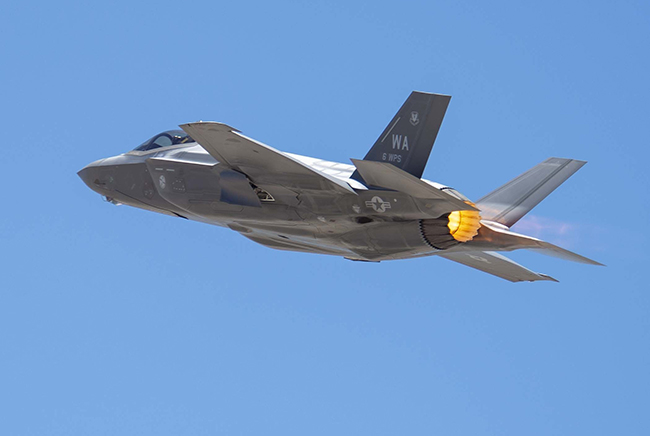
An F-35A Lightning II fighter jet assigned to the 6th Weapons Squadron takes off from Nellis AFB, Nev., on July 18, 2019. Air Force photo by A1C Bryan Guthrie.
The total cost of the F-35 program grew by $25 billion in 2018—or about $95 billion when adjusting for inflation—in part because of a new slate of upgrades known as Block 4, the Pentagon said in an annual acquisition report published Aug. 1.
Acquisition alone—including research and development, procurement, and military construction costs—rose by $15.3 billion compared to the 2012 baseline, or $22.2 billion when adjusted for inflation.
The Pentagon also noted a dispute between its cost assessment and program evaluation shop, which believes Joint Strike Fighter operations and sustainment costs are rising, and the F-35 Joint Program Office, which argues those costs are shrinking.
Lifetime costs for the entire fleet of US-operated F-35s span design and development, purchase of the jets, repairs, spare parts, modifications, upgrades, operations, military construction, and inflation over a 53-year period. The Air Force flies the F-35A; the Marine Corps the B variant; and the Navy the C variant.
Block 4 upgrades in development will modify many existing jets with new systems and weapons, and will later be added to the production line as new capabilities are needed to counter new threats. Overall development costs, which rose by $10.5 billion compared to the 2012 baseline, include the price of Block 4, designing F-35s to carry nuclear weapons, the growing costs of the Autonomic Logistics Information System, and higher expenses associated with deployability. When adjusted for inflation, development costs grew $12.4 billion.
Production costs went up, too. The most basic F-35 cost metric, known as the unit recurring flyaway cost that covers the aircraft and engine, rose by $2.1 million per airplane for the F-35A, $2.8 million for F-35B, and $900,000 for the C model. Those numbers reflect costs incurred during production prior to the ongoing Lot 11, the Pentagon said, after which the unit price is expected to plummet.
For sustainment, however, the Pentagon’s independent cost estimators parted ways with the JPO—reflecting disagreements voiced at hearings earlier this year. The CAPE office estimates that operations and sustainment grew by $9.7 billion (or $12 billion when including inflation), but the JPO said O&S decreased by $23.1 billion (or $8.5 billion when including inflation).
The program office’s O&S estimate dropped by nearly 4 percent from fiscal 2017 to 2018, following guidance from the Office of the Secretary of Defense. That dictates that estimates should account for inflation, the latest beddowns, recent labor costs, and sustainment-related changes.
Cost per flying hour dropped 2.3 percent for the F-35A, 1.8 percent for the F-35B, and 5.3 percent for the F-35C—the most up-to-date aircraft in US service. F-35A and F-35B costs dropped based on OSD guidance, while the F-35C’s cost per flying hour fell from changes to the propulsion cost estimate.